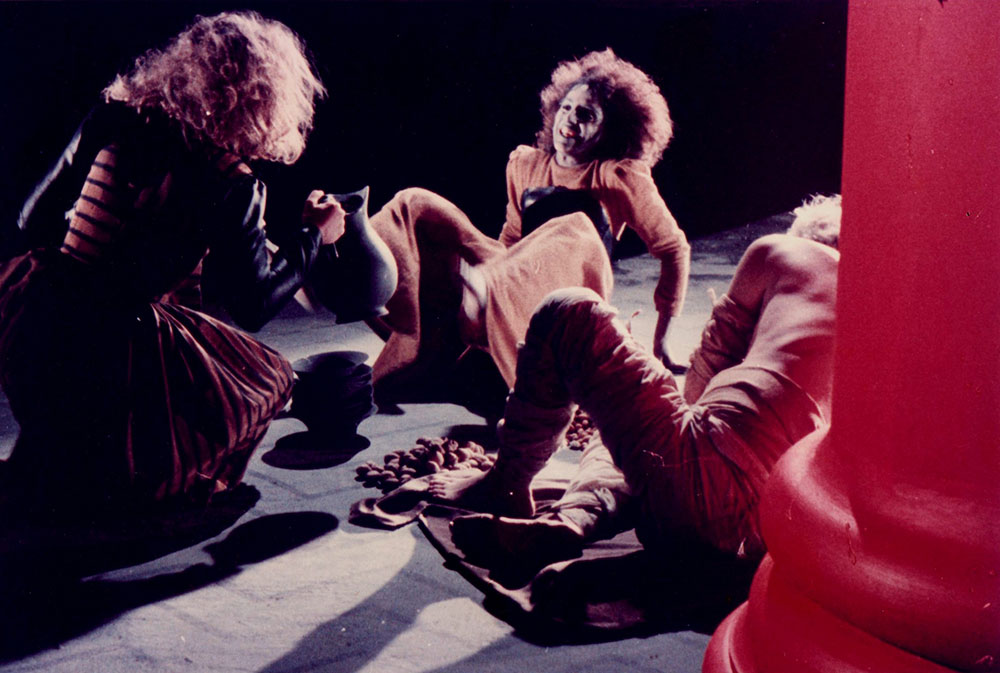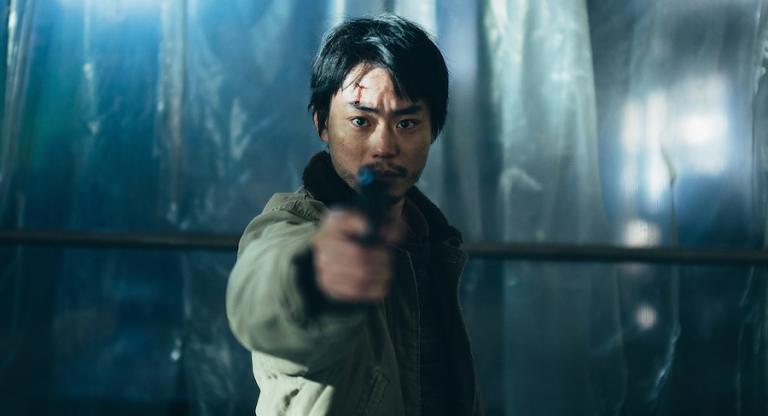The subject of Rea Walldén’s 2023 documentary Obsessive Hours at the Topos of Reality is the experimental filmmaker and visual artist Antoinetta Angelidi, a figurehead of Greek feminist avant-garde cinema. Walldén, a film theorist and professor in the Department of Digital Arts and Cinema at the National and Kapodistrian University of Athens, is Angelidi’s leading scholar, as well as her daughter and longtime collaborator. Their partnership is acutely realized in Obsessive Hours, a confessional account of Angelidi’s personal and professional milestones, guiding dreams, and the experience of going blind.
The film’s tangly title incorporates those of Angelidi’s four feature films, Idées Fixes/Dies irae (1977), Topos (1985), The Hours: A Square Film (1996), and Thief or Reality (2001). Each work is hypnagogic, elliptic, and liminal, often configuring uncanny dreamscapes with distinct rituals and temporalities with the intimacy of live theater. In Topos, this manifests as tableaux vivants depicting the function of women’s bodies in Western art; in Idées Fixes, this is the inversion of bodily and gendered codes to evoke political extremism and blinkered sociality; in The Hours, a suicidal woman wrestles with the internal pulse of memory; in Thief or Reality—co-written by Walldén—a funeral sculptress, an actor preparing for a role in Antigone, and a mother grieving her child are trapped in their impossible circumstances.
Obsessive Hours is far less oblique than Angelidi’s work, but adopts the singular tenor of her direction: phantasy and psychoanalytic murmurs—staging that reveals as it conceals. The film is set primarily in one room and cast in shadow, with only Angelidi’s face and hands discernible to the audience. Angelidi bears her existence to the audience, recounting her avant-garde practices, a traumatic rape at age 10, fleeing the Greek junta for Paris in 1973, taking up with the second-wave feminists and scholars, creeping blindness, and the eye transplants which offered her a “new gaze.” I spoke to Walldén and Angelidi about Obsessive Hours at the Topos of Reality and the legacy which it fulfills for a few hours on Orthodox Holy Friday, quite fittingly with mourning bells clanging in the distance.
Saffron Maeve: How did you go about conceiving the visual language of Obsessive Hours?
Rea Walldén: The visual language of the documentary is a tribute to Antoinetta’s films. The black background, for example, recalls her three most recent feature films [Topos, The Hours, Thief or Reality], which are immersed in darkness. [In the films] the figures arise through darkness and the idea was to have Antoinetta do the same. The surrounding three-dimensional space of the room only appears in the final quarter of the film, where you can see Antoinetta’s body; the rest of the film comprises frontal shots, where Antoinetta’s face and hands arise through the darkness. It is as if she enters unmediated into the audience’s dreams.
Antoinetta Angelidi: The time of the Covid lockdown was exactly between two transplant operations I had to regain my sight. This was a moment of deep tranquility and gratitude to the people who offered the transplants after their death. I felt a real sense of family and belonging for all of humanity, and for the first time, the need to express myself with words.
SM: In the film, Antoinetta, you recount a dream—a Magritte-style painting with slightly perceptible movements. It’s a kind of calling to create films yourself. What had your relationship been to cinema leading up to that point?
AA: There were actually two important dreams which changed my path. The first was when I was in my late teens preparing to take the examination for the Fine Arts School in Athens. It was of a cathedral made by a spider’s web, and through the holes of the web, the light entered in magical ways. It reminded me of the stained glass windows of Sainte-Chapelle in Paris. This dream made me take the exams for the School of Architecture instead of Fine Arts. In my final years at the School of Architecture, I had another dream of what I perceived to be a painting by my beloved [René] Magritte. In this painting, I saw a tiny movement; I dreamed of a moving painting. At that point, I decided to pursue cinema and also knew what kind of cinema I wanted to make—a kind I had never seen before, but it was as if my dream revealed it to me for the first time.
When I was a teenager [in the 1960s], I watched films, of course, but was not a typical cinephile. I watched a few films many times rather than many different films. It was an obsessive interest which I communicated through painting, my main passion at the time. I did a whole series of paintings inspired by [Kenji] Mizoguchi’s Ugetsu Monogatari [1953]. When I was painting, I had film in mind, and when I made films later on, I had painting in mind. My films are not so much inspired by films but by paintings, though I never used [the paintings] as they were. Representations of representations did not interest me, but deconstruction did.
SM: Rea, you’ve written extensively on the function of dreams in Antoinetta’s films, and we get a glimpse of her dream journals in Obsessive Hours. Do you keep dream journals yourself?
RW: I do keep dream journals, because apart from being Antoinetta’s collaborator and scholar, I’m her daughter, so the process of writing dream journals was taught to me as a child. This notion that we converse with our dreams was part of our reality and ways of speaking to ourselves.
AA: At a certain point, I started trying not to interpret my dreams and to just let them flow without interpretation.
RW: In my case, I enjoy interpreting my dreams at different levels… taking into account the first representation—which is always more meaningful for some reason—then the other, deeper levels.
AA: I recently read the work of a psychoanalyst, [Wilfred] Bion. He says that we dream all the time, awake and asleep, which I find very meaningful.
SM: That’s especially interesting considering Thief or Reality. The formal logic there was that one must rob reality in order to dream.
AA: Yes, reality was suffocating me. I had to open a space in the dense air that was reality in order to make art and to live.
SM: Returning to the documentary, how many of the formal aspects were planned in advance—casting Antoinetta’s personal details in monochrome and vocational details in color?
RW: In the documentary, there is a lot of improvisation, but this doesn’t imply a lack of structure. It has a very strong axis around which it worked: Antoinetta’s gaze, literally and metaphorically, structuring her art and her life; and then comes the total improvisation of Antoinetta’s narration. There were formal choices set before, such as the static camera and the staging of the space in complete black, and a central idea was that we don’t want the film’s construction to be hidden.
SM: I like the anecdote where Antoinetta mentions slowly making out shapes in the dark as a child locked in the bathroom—just as we slowly make out her body as the film progresses through changes in staging.
RW: The structural and visual choices often mirrored Antoinetta’s words. For example, Antoinetta gives a lot of importance to variations, and the documentary is structured around variation. Actually, Antoinetta has approached the notion of variation in two different ways. Firstly, she believes that, “as filmmakers we have the right to play on variations the same way that musicians and painters do” [quote from the film]. It is an experience that Antoinetta and I share, because we both paint—so you paint the same thing again and again and again. Significantly, her first film Idées fixes/Dies irae was renamed Variations on the Same Theme when it appeared in Greece. Secondly, when she regained her sight during the lockdown, she had a revelation: she understood that there is no repetition, that every time you do the same everyday actions, they are completely new.
SM: On the topic of variation, Antoinetta, you’re often cited for your unique sound design.
AA: I perceive the heterogeneous elements of sound—speech, music, noise—as a unity, a continuum. This approach originates from my loss of speech at age 10. It was then that speech became for me a cloud of noise. Even later on, when I had regained the ability to understand, there were moments when people were speaking but the meaning of speech was being removed—mouths opening and closing. I felt this particularly strongly with political indoctrination. I felt this also when I first went to France because I didn’t really speak French, so this woke up memories of my childhood and the recurring experience of not understanding the meaning of words. Remembering myself as a child, a feeling that all immigrants have, began my creative path in film. That is why I like Recitations by [Georges] Aperghis [the composer], elements of which I integrated into Topos.
SM: Your work was shaped in large part by the social and political groups you moved through: Greek refugees, second-wave feminists, Marxism, psychoanalysis. Are there contemporary social groups, movements, or artistic collectives you feel drawn to?
AA: Yes, I feel close to the queer movement. Using today’s queer theory, I feel that I was non-binary in my adolescence and first adulthood. Of course, at the time, there was no theorization of that, so I basically felt as though I was a non-woman. But when I met the second wave of feminists in Paris, through solidarity to other women, I accepted that I was a woman among different kinds of women.
SM: Considering your dual positionality as filmmakers and scholars—and Antoinetta, your experience as an artist for 50 years—what do you make of the present experimental film landscape?
RW: [Experimental film] will always be meaningful as a way to change things because to see differently allows you to act differently. It is the concept of art as a revolution, as a way to see the world anew. This is not a question of whether cinema or any particular art has a future or a meaning, but what we do as human beings, seeing and making art, and living our lives.
AA: The aim of cinema and art—the way I felt it in my films and taught it to my students—is to create your own gaze, your own point of view. The entirety of civilization and culture is the corpus of everything made by humans—it is the first material for every new artist and filmmaker. Using that material and going deep within their unconscious, using the mechanism of dreams and experimentation, they have to find their own gaze. The objective is to see the world anew, from the beginning, every time—to reinvent cinema from the beginning, every time. This will always be the demand [of experimental film] as long as there is cinema, or rather, as long as there is humanity. Although, we are not quite sure how long that will be.
Topos screens tonight, May 12, at Anthology Film Archives on 35mm as part of Prismatic Ground’s “Wave 4: ping pong ping pong ping pong ping pong ping pong.”



